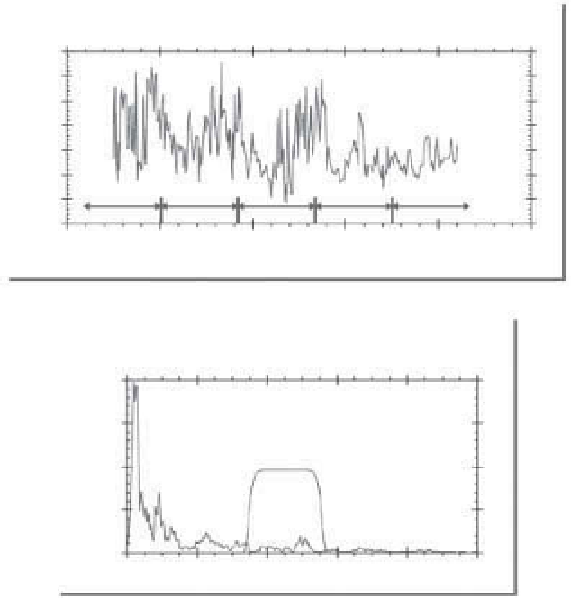Geology Reference
In-Depth Information
Garcia logARM - GOLDHAMMER 405kyr time
TOTAL DURATION: 1845.56 KILOYEARS
-4
-4.5
-5
-5.5
-6
-6.5
-7
-7.5
sequences
405
405
405
405
405
-500
0
500
1000
1500
2000
kiloyears upsection
Garcia logARM
GOLDHAMMER 405kyr time
2
π
MTM Power spectrum
20
405-kyr
(tuned-COLDHAMMER 4th order sequences)
15
0.035, 0.045, 0.055
precession
passband
10
100 kyr
5
20 kyr
44 kyr
0
0
0.02
0.04
0.06
0.08
0.1
cycles/kyr
Fig. 8.17
The Cupido ARM cyclostratigraphy is tuned by tying the fourth-order sequence boundaries to long eccentricity
(405 kyr periods). The time series analysis of the resulting ARM time series shows power at other Milankovitch frequencies
(precession: 20 kyr; obliquity: 44 kyr; and short eccentricity: 100 kyr). From LA Hinnov, D Anastasio, D Latta, K Kodama and
M Elrick, Milankovitch-controlled paleoclimate signal recorded by rock magnetics, Lower Cretaceous Platform carbonates of
northern Mexico, American Association of Petroleum Geologists, Search and Discovery Article #40388, 2009, AAPG. The
range of expected precession frequencies (0.035, 0.045 and 0.055 cycles/kyr) are shown in the bottom plot. (See Colour
Plate 23)
Further tuning at short eccentricity by fi ltering the
ARM time series at the tuning frequency for better
comparison to the theoretical time series of course
sharpens the short eccentricity peak, but signifi cantly
reduces the
c.
200 kyr peak to below 99% confi dence
level for the red noise. The precession peaks stay strong.
This would suggest that the 200 kyr peak that was
so strong in the untuned ARM time series may have
been an artifact of varying sediment accumula-
tion rates and/or hiatuses in the section, although
it should not be entirely dismissed as representing a
real, but non-Milankovitch, cycle. The ARM record
therefore provides good evidence that rock magnetic
cyclostratigraphy can give a high-resolution chronos-
tratigraphy, at the precessional timescale, for these
growth strata.
An even more detailed study in the form of a coher-
ency analysis, that compares the phase of the tuned
ARM series to the phase of the precession-scale insola-
tion, suggests that the precession peaks are in phase
with autumn insolation peaks. The phase of precession
insolation changes by 180° between June and Decem-
ber. Since the record was tuned to eccentricity, preces-
sion's phase should not be affected by the tuning. This
observation suggests to Kodama
et al.
(2010) that the
ARM is climate encoded by continental runoff that
peaks during the fall rainy season in the Mediterranean
paleoclimate for the Arguis Formation in the Eocene.
This demonstrates the rich amount of information to
be gleaned from detailed cyclostratigraphic analysis of
good rock magnetic cyclostratigraphic records.
THE LATEMAR CONTROVERSY
The last example of rock magnetic cyclostratigraphy
in this section is the so-called Latemar controversy.
The basis for the controversy is simply that different
geochronological techniques give different results for
the duration of the deposition of a thick platform





Search WWH ::

Custom Search